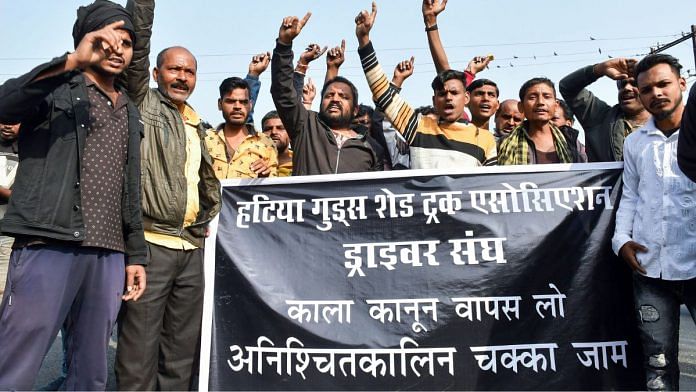New Delhi: A penal provision for hit-and-run cases in the new, yet-to-be-implemented, Bharatiya Nyaya (Second) Sanhita (BNS) 2023, which is set to replace the existing Indian Penal Code (IPC), triggered massive nationwide protests by transporters earlier this week.
Section 106 (2) of the BNS provides for a jail term of up to 10 years in hit-and-run cases — a significant increase from the current provision under the IPC that usually leads to a punishment of up to two years of imprisonment in such cases.
Truck drivers have been protesting against the provision since Monday, resulting in panic buying of fuel and essential items in several states. The protest — involving bus, truck and tanker drivers — was called off Wednesday, after assurances from the Union government that the new laws wouldn’t be implemented until talks with drivers’ unions.
In a release Tuesday, the government had said it has taken cognisance of the concerns of truckers and held detailed discussions with the representatives of the All India Motor Transport Congress (AIMTC), the apex body of transporters in the country.
“The government wants to point out that these new laws and provisions have not yet come into force. We would also like to point out that the decision to invoke Section 106 (2) of the Bharatiya Nyay Sanhita will be taken only after consultation with the All India Motor Transport Congress,” it assured.
Meanwhile, advocate Ashwini Dubey was quoted by News X as saying that the law aims to reduce the number of hit-and-run cases.
He explained that while the law imposes stricter penalties for hit-and-run cases, the ultimate say still rests with the court, which will decide whether the accused driver is guilty or not, and what punishment should be imposed.
ThePrint explains what the new law says, how it is different from the old one and why truckers were protesting over it.
Also Read: New criminal laws, data protection to women’s reservation — 10 significant laws passed in 2023
What does the law say
Section 106 of the new law talks about death by negligence.
Clause 2 of this provision says, “Whoever causes death of any person by rash and negligent driving of vehicle not amounting to culpable homicide, and escapes without reporting it to a police officer or a Magistrate soon after the incident, shall be punished with imprisonment of either description of a term which may extend to ten years, and shall also be liable to fine.”
In essence, it provides for a jail term of up to 10 years, along with a fine, for anybody who causes the death of a person through rash and negligent driving, and who then escapes without reporting the incident to a police officer or a magistrate.
The IPC does not have a dedicated provision for hit-and-run cases. Such cases would usually be tried under Section 304A of the IPC, which says, “Whoever causes the death of any person by doing any rash or negligent act not amounting to culpable homicide, shall be punished with imprisonment of either description for a term which may extend to two years, or with fine, or with both.”
It, therefore, provides for a jail term of two years, or a fine or both, for causing the death of a person through a rash or negligent act.
Additionally, Section 279 of the IPC speaks of rash driving, and provides for a six-month jail term, or a Rs 1,000 fine, or both, for anybody who drives any vehicles rashly or negligently, in a manner that may endanger human life or may be likely to cause hurt or injury to any person.
Why are transporters protesting?
Transporters’ associations across the country have been protesting against the BNS provision for the past two days. Their concerns include the risk to drivers from mobs if they do not escape an accident, and the sudden increase in the jail term for such accidents.
The Section 106 (2) of BNS provision does not provide clarity on how an accused or a driver should inform the authorities, considering the chances of mob anger at the scene of the crime.
All India Motor Transport Congress (AIMTC) member Bal Malkit Singh was quoted by The Indian Express as saying, “We are not demanding that those who drink and drive or drivers who drive rashly should be dealt with kid gloves. But there have been many cases where drivers have got involved in accidents for no fault of theirs and people have gathered in mobs to beat them up. Sometimes the mobs also burn the vehicle and the drivers have to run for their safety.”
The AIMTC has demanded the withdrawal of the new provision.
“A truck costs Rs 50 lakh but is often carrying material worth crores, no driver would be stupid enough to leave their goods behind. The drivers know that they can be traced and in most cases, drivers go back and surrender on their own,” Singh added.
Delhi High Court advocate Mukesh Mehra has been quoted in the media as saying, however, that there was a need to step up the law on hit-and-run to ensure accountability, because of the “rise in the number of such cases” in recent years. The lawyer also suggested ways to ensure that it is not unfairly tilted towards drivers.
“Truck drivers come from the most marginalised and poor sections of our country. To ease the grip, lawmakers can revise and reduce the penalty applied, with no compulsion to reduce the conviction period. Moreover, a majority of truck drivers are not truck owners. The penalty can be applied on a ‘shared basis’ between the truck driver and owner of the truck,” he was quoted as saying in Logistics Insider.
(Edited by Richa Mishra)
Also Read:Police, judicial custody & use of handcuffs — how new bills may make criminal laws harsher



